OCZ Vector (256GB) Review
by Anand Lal Shimpi on November 27, 2012 9:10 PM ESTAnandTech Storage Bench 2011
Two years ago we introduced our AnandTech Storage Bench, a suite of benchmarks that took traces of real OS/application usage and played them back in a repeatable manner. I assembled the traces myself out of frustration with the majority of what we have today in terms of SSD benchmarks.
Although the AnandTech Storage Bench tests did a good job of characterizing SSD performance, they weren't stressful enough. All of the tests performed less than 10GB of reads/writes and typically involved only 4GB of writes specifically. That's not even enough exceed the spare area on most SSDs. Most canned SSD benchmarks don't even come close to writing a single gigabyte of data, but that doesn't mean that simply writing 4GB is acceptable.
Originally I kept the benchmarks short enough that they wouldn't be a burden to run (~30 minutes) but long enough that they were representative of what a power user might do with their system.
Not too long ago I tweeted that I had created what I referred to as the Mother of All SSD Benchmarks (MOASB). Rather than only writing 4GB of data to the drive, this benchmark writes 106.32GB. It's the load you'd put on a drive after nearly two weeks of constant usage. And it takes a *long* time to run.
1) The MOASB, officially called AnandTech Storage Bench 2011 - Heavy Workload, mainly focuses on the times when your I/O activity is the highest. There is a lot of downloading and application installing that happens during the course of this test. My thinking was that it's during application installs, file copies, downloading and multitasking with all of this that you can really notice performance differences between drives.
2) I tried to cover as many bases as possible with the software I incorporated into this test. There's a lot of photo editing in Photoshop, HTML editing in Dreamweaver, web browsing, game playing/level loading (Starcraft II & WoW are both a part of the test) as well as general use stuff (application installing, virus scanning). I included a large amount of email downloading, document creation and editing as well. To top it all off I even use Visual Studio 2008 to build Chromium during the test.
The test has 2,168,893 read operations and 1,783,447 write operations. The IO breakdown is as follows:
| AnandTech Storage Bench 2011 - Heavy Workload IO Breakdown | ||||
| IO Size | % of Total | |||
| 4KB | 28% | |||
| 16KB | 10% | |||
| 32KB | 10% | |||
| 64KB | 4% | |||
Only 42% of all operations are sequential, the rest range from pseudo to fully random (with most falling in the pseudo-random category). Average queue depth is 4.625 IOs, with 59% of operations taking place in an IO queue of 1.
Many of you have asked for a better way to really characterize performance. Simply looking at IOPS doesn't really say much. As a result I'm going to be presenting Storage Bench 2011 data in a slightly different way. We'll have performance represented as Average MB/s, with higher numbers being better. At the same time I'll be reporting how long the SSD was busy while running this test. These disk busy graphs will show you exactly how much time was shaved off by using a faster drive vs. a slower one during the course of this test. Finally, I will also break out performance into reads, writes and combined. The reason I do this is to help balance out the fact that this test is unusually write intensive, which can often hide the benefits of a drive with good read performance.
There's also a new light workload for 2011. This is a far more reasonable, typical every day use case benchmark. Lots of web browsing, photo editing (but with a greater focus on photo consumption), video playback as well as some application installs and gaming. This test isn't nearly as write intensive as the MOASB but it's still multiple times more write intensive than what we were running in 2010.
As always I don't believe that these two benchmarks alone are enough to characterize the performance of a drive, but hopefully along with the rest of our tests they will help provide a better idea.
The testbed for Storage Bench 2011 has changed as well. We're now using a Sandy Bridge platform with full 6Gbps support for these tests.
AnandTech Storage Bench 2011 - Heavy Workload
We'll start out by looking at average data rate throughout our new heavy workload test:

Here it is. OCZ's Vector comes within 4% of Samsung's SSD 840 Pro and manages a 22% increase in performance compared to the Vertex 4. The breakdown shows Vector's strong write performance are really what push it over the edge. At the same time, OCZ has finally addressed whatever poor read performance issues plagued the Vertex 4 in our test - the Vector is a different beast here.
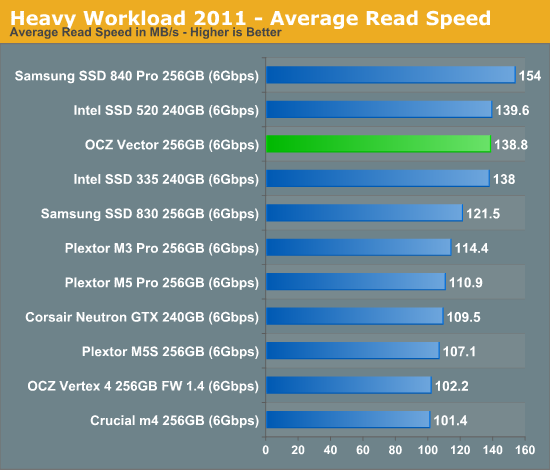
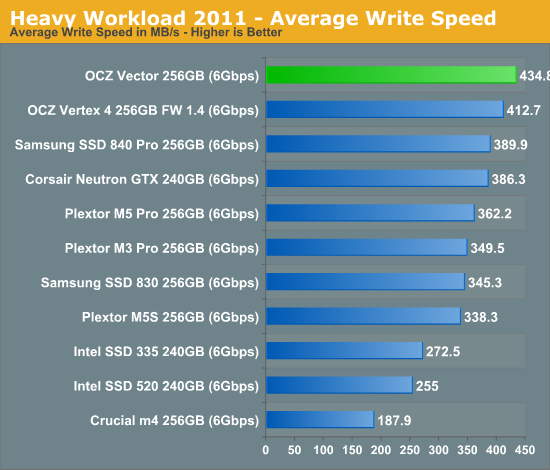
The next three charts just represent the same data, but in a different manner. Instead of looking at average data rate, we're looking at how long the disk was busy for during this entire test. Note that disk busy time excludes any and all idles, this is just how long the SSD was busy doing something:
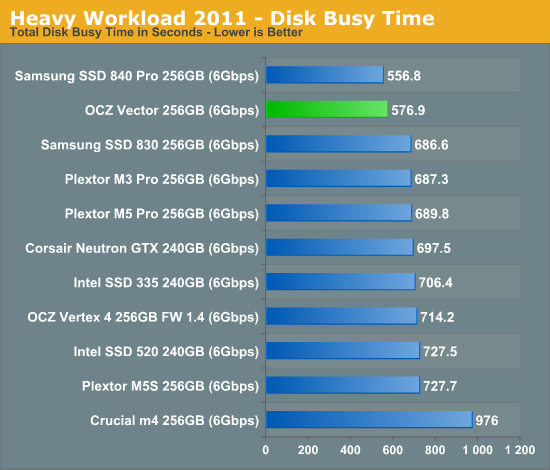
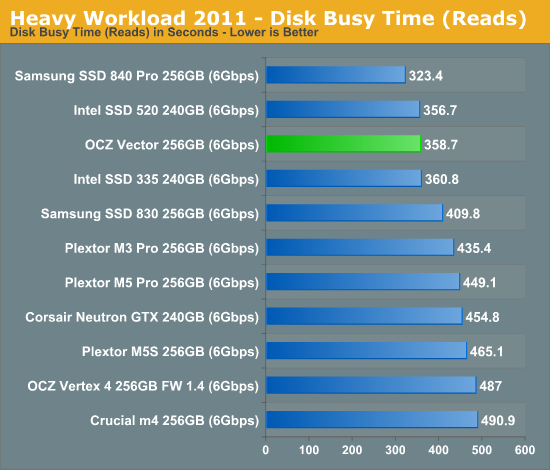
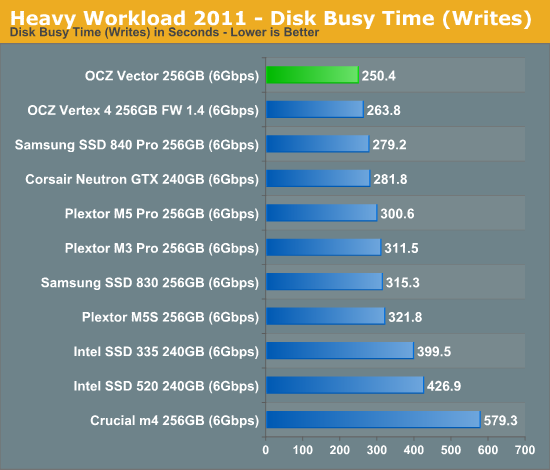










151 Comments
View All Comments
melgross - Wednesday, November 28, 2012 - link
What does that mean; usable space? Every OS leaves a different amount after formatting, so whether the drive is rated by GB or GiB, the end result would be different. Normally, SSD's are rated as to the around seen by the OS, not by that plus the around overrated. So it isn't really a problem.Actually, the differences we're talking about isn't all that much, and is more a geeky thing to concern oneself with more than anything else. Drives are big enough, even SSD's, so that a few GB's more or less isn't such a big deal.
Kristian Vättö - Wednesday, November 28, 2012 - link
An SSD can't operate without any over-provisioning. If you filled the whole drive, you would end up in a situation where the controller couldn't do garbage collection or any other internal tasks because every block would be full.Drive manufacturers are not the issue here, Microsoft is (in my opinion). They are using GB while they should be using GiB, which causes this whole confusion. Or just make GB what it really is, a billion bytes.
Holly - Thursday, November 29, 2012 - link
Sorry to say so, but I am afraid you look on this from wrong perspective. Unless you are IT specialist you go buy a drive that says 256GB and expect it to have 256GB capacity. You don't care how much additional space is there for replacement of bad blocks or how much is there for internal drive usage... so you will get pretty annoyed by fact that your 256GB drive would have let's say 180GB of usable capacity.And now this GB vs GiB nonsense. From one point of view it's obvious that k,M,G,T prefixes are by default *10^3,10^6,10^9,10^12... But in computers capacity units they used to be based on 2^10, 2^20 etc. to allow some reasonable recalculation between capacity, sectors and clusters of the drive. No matter what way you prefer, the fact is that Windows as well as many IDE/SATA/SAS/SCSI controllers count GB equal to 2^30 Bytes.
Random controllers screenshots from the internet:
http://www.cisco.com/en/US/i/100001-200000/190001-...
http://www.cdrinfo.com/Sections/Reviews/Specific.a...
http://i.imgur.com/XzVTg.jpg
Also, if you say Windows measurement is wrong, why is RAM capacity shown in 'GB' but your 16GB shown in EVERY BIOS in the world is in fact 16384MiB?
Tbh there is big mess in these units and pointing out one thing to be the blame is very hasty decision.
Also, up to some point the HDD drive capacity used to be in 2^k prefixes long time ago as well... still got old 40MB Seagate that is actually 40MiB and 205MB WD that is actually 205MiB. CD-Rs claiming 650/700MB are in fact 650/700MiB usable capacity. But then something changed and your 4.7GB DVD-R is in fact 4.37GiB usable capacity. And same with hard discs...
Try to explain angry customers in your computer shop that the 1TB drive you sold them is 931GB unformatted shown both by controller and Windows.
Imho nobody would care slightest bit that k,M,G in computers are base 2 as long as some marketing twat didn't figure out that his drive could be a bit "bigger" than competition by sneaking in different meaning for the prefixes.
jwilliams4200 - Thursday, November 29, 2012 - link
It is absurd to claim that "some marketing twat didn't figure out that his drive could be a bit "bigger" than competition by sneaking in different meaning for the prefixes".The S.I. system of units prefixes for K, M, G, etc. has been in use since before computers were invented. They have always been powers of 10. In fact, those same prefixes were used as powers of ten for about 200 years, starting with the introduction of the metric system.
So those "marketing twats" you refer to are actually using the correct meaning of the units, with a 200 year historical precedent behind them.
It is the johnny-come-latelys that began misusing the K, M, G, ... unit prefixes.
Fortunately, careful people have come up with a solution for the people incorrectly using the metric prefixes -- it is the Ki, Mi, Gi prefixes.
Unfortunately, Microsoft persists in misusing the metric prefixes, rather than correctly using the Ki, Mi, Gi prefixes. That is clearly a bug in Microsoft Windows. Kristian is absolutely correct about that.
Holly - Friday, November 30, 2012 - link
How much RAM does your bios report you have?Was the BIOS of your motherboard made by Microsoft?
jwilliams4200 - Friday, November 30, 2012 - link
Would you make that argument in front of a judge?"But judge, lots of other guys stole cars also, it is not just me, so surely you can let me off the hook on these grand-theft-auto charges!"
Touche - Saturday, December 1, 2012 - link
No, he is right. Everything was fine until HDD guys decided they could start screwing customers for bigger profits. Microsoft and everyone else uses GB as they should with computers. It was HDD manufacturers that caused this whole GB/GiB confusion regarding capacity.jwilliams4200 - Saturday, December 1, 2012 - link
I see that you are a person who never lets the facts get in the way of a conspiracy theory.Touche - Monday, December 3, 2012 - link
http://betanews.com/2006/06/28/western-digital-set...Holly - Monday, December 3, 2012 - link
Well, 2^10k prefixes marked with 'i' were made in a IEC in 1998, in IEEE in 2005, alas the history is showing up frequent usage of both 10^3k and 2^10k meanings. Even with IEEE passed in 2005 it took another 4 years for Apple (who were the first with OS running with 2^10k) to turn to 'i' units and year later for Ubuntu with 10.10 version.For me it will always make more sense to use 2^10k since I can easily tell size in kiB, MiB, GiB etc. just by bitmasking (size & 11111111110000000000[2]) >> 10 (for kiB). And I am way too used to k,M,G with byte being counted for 2^10k.
Some good history reading about Byte prefixes can be found at http://en.wikipedia.org/wiki/Timeline_of_binary_pr... ...
Ofc, trying to reason with people who read several paragraph post and start jumping around for one sentence they feel offended with is useless.
But honestly even if kB was counted for 3^7 bytes it wouldn't matter... as long as everyone uses the same transform ratio.